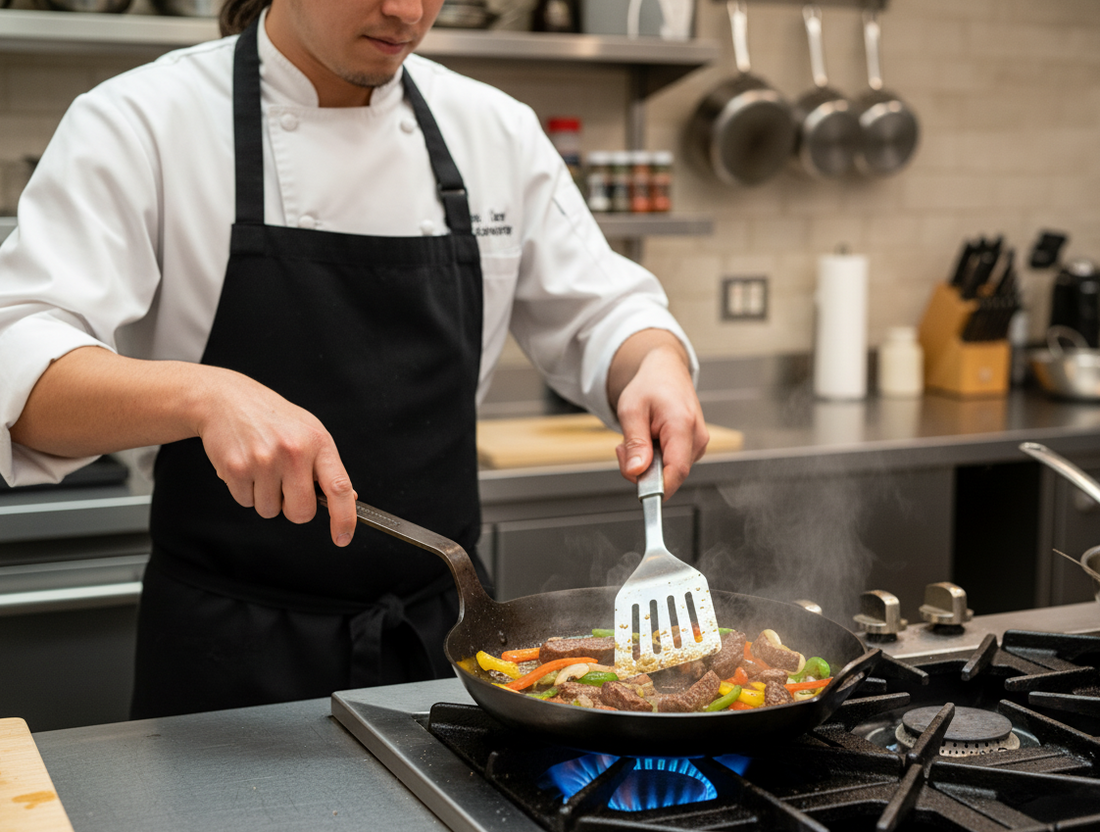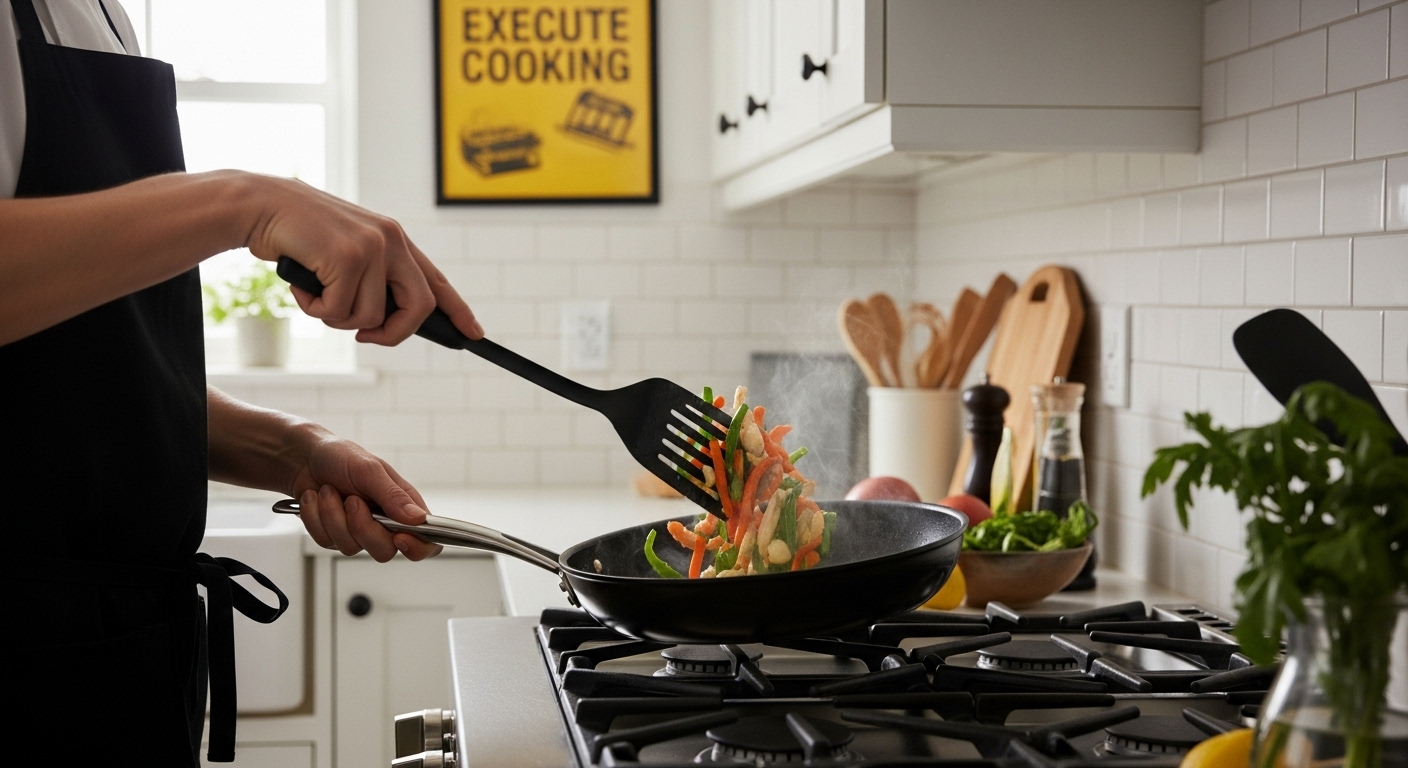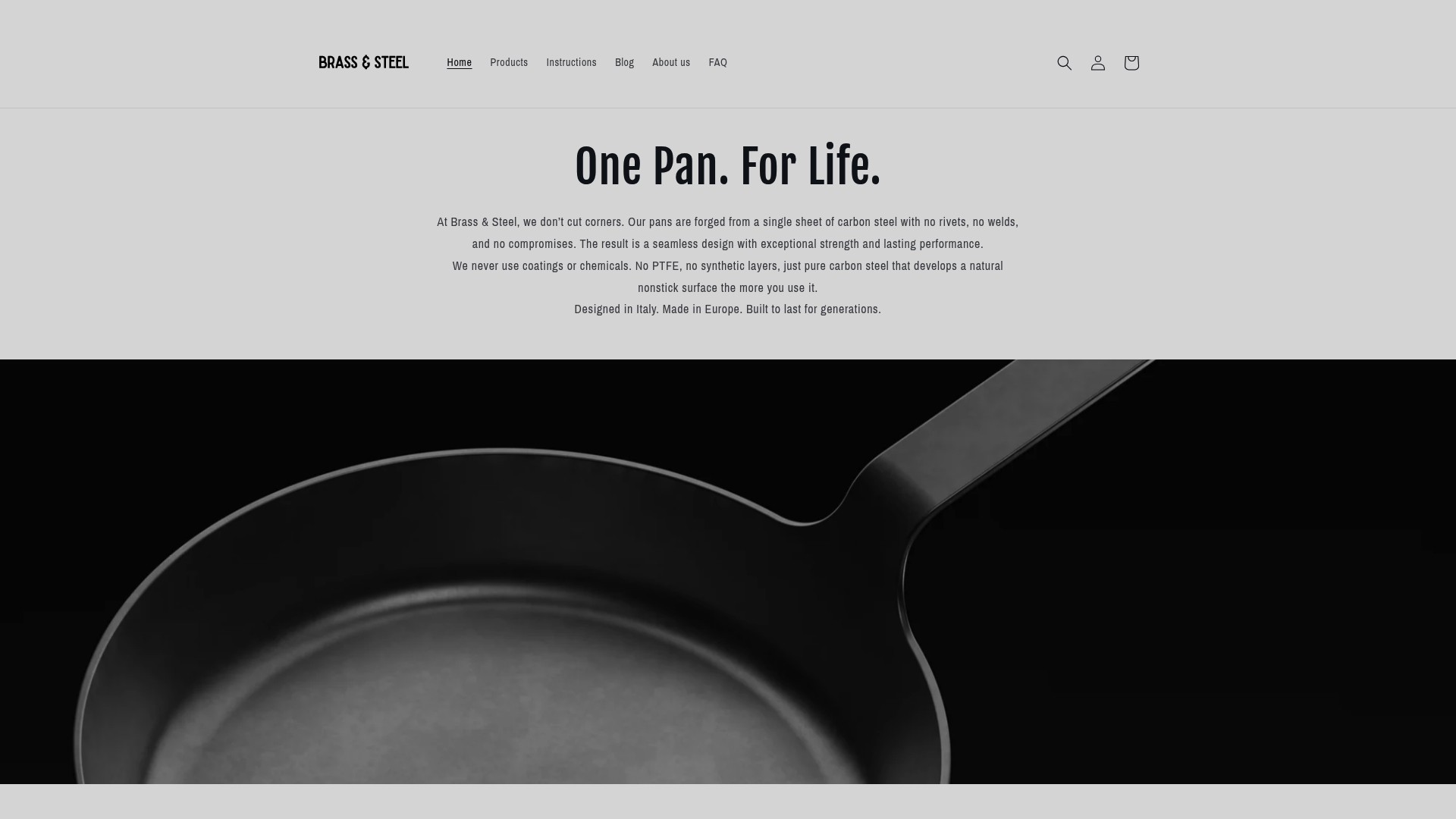
Cooking with Carbon Steel Step by Step: Mastering Techniques
Share
Carbon steel pans have a reputation for outperforming almost any other cookware in the kitchen. Many Michelin-starred chefs swear by them and for good reason. A well-maintained carbon steel pan can last for decades and gets better with each use. Surprised? Most people think their greatest strength is durability. Actually, their real power comes from how they transform with care and skill—turning your cooking into an experience that rivals the professionals.
Table of Contents
- Step 1: Choose Quality Carbon Steel Cookware
- Step 2: Season Your Carbon Steel Pans Properly
- Step 3: Preheat The Pan For Optimal Cooking
- Step 4: Execute Cooking Techniques With Care
- Step 5: Verify Cooking Progress Regularly
- Step 6: Clean And Maintain Your Carbon Steel Cookware
Quick Summary
| Key Point | Explanation |
|---|---|
| 1. Choose high-quality carbon steel pans | Look for thickness between 2-4mm for durability and even heat distribution. Assess the pan’s weight to gauge its quality. |
| 2. Properly season the pan | Use high smoke point oils and apply thin layers. Repeat the process multiple times to create a strong, nonstick surface. |
| 3. Preheat the pan correctly | Gradually heat your pan to optimize cooking. Use the water droplet test to determine perfect temperature before adding food. |
| 4. Monitor cooking progress regularly | Check for visual and auditory cues like sizzle sounds and colour changes to avoid burning and ensure even cooking. |
| 5. Clean and maintain regularly | Wash the pan with hot water, avoid soap, and re-oil after drying to preserve seasoning and prevent rust. |
Step 1: Choose Quality Carbon Steel Cookware
Choosing the right carbon steel cookware is a pivotal first step in mastering cooking techniques that will transform your culinary experience. Not all carbon steel pans are created equal, and understanding what distinguishes an exceptional pan from an average one requires careful consideration of several critical factors.
First, thickness matters significantly. Professional chefs know that a well-crafted carbon steel pan should have substantial gauge thickness between 2-4mm. Thicker pans provide superior heat distribution, more even cooking, and greater durability. Thin pans will warp, heat unevenly, and deteriorate quickly under high cooking temperatures. When examining potential pans, pick them up and assess their weight this gives you an immediate sense of quality construction.
Construction quality is equally paramount. Look for pans forged from a single piece of carbon steel, which eliminates weak points like rivets or welded seams. Learn more about selecting the ideal carbon steel pan to understand the nuanced characteristics that separate exceptional cookware from standard options. A seamless design ensures better heat transfer, easier cleaning, and increased structural integrity.
Handle design requires careful scrutiny. The ideal carbon steel pan handle should be sturdy, stay relatively cool during stovetop cooking, and provide a comfortable grip. Wooden or steel handles with ergonomic design demonstrate superior craftsmanship. Test the handle’s balance and weight distribution to ensure comfortable manoeuvring during complex cooking techniques.
Finally, consider versatility. The best carbon steel cookware transitions seamlessly between stovetop and oven, supports multiple cooking methods, and works across different heat sources. Induction compatibility, even heat distribution, and a naturally developing nonstick surface through proper seasoning are hallmarks of a high-quality carbon steel pan. When you find a pan meeting these criteria, you are not just purchasing cookware but investing in a culinary companion that will serve you for decades.
Below is a comparison table outlining key criteria for choosing quality carbon steel pans, summarising construction, handle design, versatility, and their respective advantages.
| Feature | What to Look For | Why It Matters |
|---|---|---|
| Thickness | 2–4mm, substantial weight | Ensures durability and even heat distribution |
| Construction Quality | Single-piece forged carbon steel | Eliminates weak points, easier cleaning, better heat |
| Handle Design | Ergonomic, sturdy, stays cool | Comfort, safety, and control during manoeuvring |
| Versatility | Oven/stovetop safe, induction compatible | Supports various cooking methods; broad compatibility |
| Seasoning Potential | Ability to develop nonstick patina | Improves with use, resists sticking and rust |
Step 2: Season Your Carbon Steel Pans Properly
Seasoning transforms a raw carbon steel pan into a culinary powerhouse with a naturally nonstick surface that improves with every cooking session. This crucial process creates a protective layer that prevents rust, enhances cooking performance, and develops a rich patina that professional chefs prize. Learn more about creating the perfect pan seasoning to understand the nuanced art of pan preparation.
High smoke point oils are essential for successful seasoning. Grapeseed, avocado, and refined sunflower oils work best because they polymerize effectively at high temperatures. Begin by thoroughly cleaning your new pan with hot water and a soft sponge, removing any protective factory coating. Dry the pan completely using a clean cloth or paper towel, ensuring no moisture remains that could compromise the seasoning process.
Preheat your oven to 250°C, creating an environment that allows oil to bond permanently with the pan’s surface. Apply a microscopic thin layer of oil, wiping away excess until the pan looks almost dry. This technique prevents pooling and ensures an even, durable seasoning. Place the pan upside down in the oven to allow any remaining oil to distribute evenly and prevent dripping. Bake for approximately 30 minutes, then turn off the oven and let the pan cool naturally inside.
Repeat this process two to three times to build a robust initial seasoning. Each subsequent layer increases the pan’s nonstick properties and durability. Professional chefs recommend cooking fatty foods like bacon or searing meats during initial uses, as these help strengthen the seasoning. Watch for a dark, smooth surface that indicates a well-seasoned pan.
Avoid cooking acidic foods during the first few uses, as these can strip away the developing protective layer. With patience and proper technique, your carbon steel pan will develop a beautiful, functional surface that rivals professional cookware, becoming more nonstick and resilient with each meal you prepare.
Step 3: Preheat the Pan for Optimal Cooking
Preheating a carbon steel pan is a critical technique that separates amateur cooks from culinary professionals. Proper preheating ensures consistent heat distribution, prevents food from sticking, and creates those coveted restaurant-quality sear marks that elevate home cooking. Explore advanced cooking techniques with your carbon steel pan to understand the nuanced art of temperature control.
Begin by placing your carbon steel pan on a medium heat source, allowing it to warm gradually. Avoid high heat initially, as rapid temperature changes can damage the pan’s carefully developed seasoning. Professional chefs recommend a slow, methodical approach that allows the entire pan to heat evenly. Move the pan gently across the burner, rotating it to ensure uniform temperature distribution. This technique prevents hot spots that can cause uneven cooking and potential food burning.
To test if your pan is perfectly preheated, perform the water droplet test. Sprinkle a few drops of water onto the pan’s surface. If the water forms small, dancing beads that move across the pan without immediately evaporating, you have reached the ideal cooking temperature. This phenomenon, known as the Leidenfrost effect, indicates that your pan is precisely heated for optimal cooking. Should the water evaporate instantly, the pan is too hot. Conversely, if the water sits and steams without movement, the pan needs more heating.
Different cooking techniques require slightly varied preheating approaches. Searing meats demands a higher temperature with a longer preheating time, while delicate foods like eggs or fish require a more gentle, moderate heat. Always pay attention to the pan’s surface color and heat intensity.
A properly preheated carbon steel pan will have a slight shimmer and uniform warmth, signaling it is ready to transform your ingredients into culinary masterpieces. Remember that mastering preheating is a skill developed through practice, patience, and careful observation.
Step 4: Execute Cooking Techniques with Care
Mastering cooking techniques in a carbon steel pan requires precision, patience, and an understanding of how heat interacts with different ingredients. The pan is your canvas, and ingredients are your paint. Discover advanced searing techniques for professional results to elevate your culinary skills beyond basic cooking methods.
Searing meat demands absolute concentration. Remove the meat from refrigeration 15-20 minutes before cooking, allowing it to reach room temperature. Pat the surface completely dry with paper towels, as moisture prevents achieving that coveted golden-brown crust. When placing meat in the pan, lay it away from you to prevent potential oil splatter. Drop the meat gently, allowing it to make full contact with the pan’s surface. Resist the urge to move or flip the meat immediately. Professional chefs know that creating a perfect sear requires letting the protein develop a rich, caramelized exterior before turning.
Stir-frying represents another technique requiring nuanced control. Prepare all ingredients before heating the pan, a method known as mise en place. Cut vegetables and proteins into uniform sizes to ensure even cooking. When the pan reaches the correct temperature, add oil with a high smoke point like refined sunflower or grapeseed. Use swift, continuous movements to keep ingredients moving, preventing burning while allowing slight caramelization. The key is maintaining high heat and constant motion, creating dishes with vibrant colors and perfectly cooked textures.

Understanding your carbon steel pan’s heat zones is crucial. Some areas will be hotter than others, especially on home stovetops. Rotate and move ingredients accordingly, using cooler pan regions for gentler cooking and hot spots for quick searing. Watch for visual cues: shimmering oil, slight smoke, and ingredient color changes indicate you are executing techniques correctly. Remember that carbon steel pans are forgiving yet demanding. Each cooking session builds your skills, transforming you from a home cook into a confident culinary artist.
Step 5: Verify Cooking Progress Regularly
Verifying cooking progress in a carbon steel pan is an art form that separates exceptional cooks from average ones. Constant vigilance prevents culinary disasters and transforms potential meal mishaps into perfectly executed dishes. Explore advanced cooking monitoring techniques to elevate your kitchen skills and understand the nuanced signals your cookware provides.
Visual and auditory cues are your primary verification tools. Listen to the sizzle of ingredients, which tells a story about heat intensity and cooking progression. A gentle, consistent sizzle indicates optimal cooking temperature, while aggressive popping or sudden silence suggests potential burning or insufficient heat. Watch the color transformation of ingredients. Proteins develop a golden-brown crust through caramelization, while vegetables transition from raw to vibrant, slightly translucent states. Use a flexible, heat-resistant spatula to gently lift and inspect the underside of meats, checking for that perfect sear without disrupting the cooking process.
Temperature monitoring requires more than intuition. Professional chefs recommend using an instant-read digital thermometer to confirm internal temperatures, especially when cooking meats. For steaks, medium-rare registers around 54°C, while chicken requires a minimum of 74°C to ensure food safety. Insert the thermometer into the thickest part of the protein, avoiding contact with bone or fat. Remember that carbon steel pans retain heat remarkably well, so remove items slightly before reaching the exact target temperature. The residual heat will continue cooking the food, preventing overdone, tough textures.
Develop a rhythm of gentle interventions. Rotate vegetables periodically to ensure even cooking, lift proteins to check caramelization, and adjust flame intensity as needed. Your carbon steel pan communicates through temperature, sound, and visual changes. Learning to read these signals transforms cooking from a mechanical process into an intuitive dialogue between cook, cookware, and cuisine. Trust your senses, but verify with precision.
Step 6: Clean and Maintain Your Carbon Steel Cookware
Cleaning and maintaining your carbon steel cookware is not just a chore but a ritual that preserves your pan’s performance and longevity. Proper care transforms a good pan into an exceptional culinary companion. Explore our comprehensive guide to carbon steel pan maintenance to understand the nuanced techniques that professionals use to keep their cookware in pristine condition.
Immediately after cooking, clean the pan while it is still warm. Avoid using harsh detergents or abrasive scrubbers that can strip away the carefully developed seasoning. Instead, use hot water and a soft sponge or chainmail scrubber to gently remove food residue. For stubborn stuck-on bits, create a paste using coarse salt and a small amount of water. Gently scrub in circular motions, allowing the salt to act as a mild, natural abrasive. Rinse thoroughly with hot water, ensuring no salt crystals remain. Professional chefs recommend avoiding soap whenever possible, as it can break down the pan’s protective seasoning layer.
Drying and re-oiling are crucial steps in maintaining your carbon steel pan’s performance. After washing, place the pan on a low heat source to evaporate any remaining moisture completely. Use a clean paper towel or lint-free cloth to apply a thin, even layer of high smoke point oil like grapeseed or refined sunflower. The key is using minimal oil – the pan should look almost dry, with just a gossamer-thin protective coating. This process prevents rust and continues to build a robust, natural nonstick surface. Store the pan in a dry place with good air circulation, preferably hanging or standing upright to allow air flow around the entire surface.
Periodic maintenance is your pan’s secret to longevity. If you notice the seasoning becoming dull or sticky, it is time for a complete re-seasoning. Strip the pan back to bare metal using steel wool if necessary, then repeat the initial seasoning process. Watch for signs of neglect: rust spots, uneven seasoning, or a rough surface texture. Your carbon steel pan is a living tool that responds to care, improving with each careful cleaning and thoughtful maintenance session.
The following table summarises the typical problems encountered during carbon steel pan care, along with their common causes and practical solutions as addressed in the guide.
| Problem | Likely Cause | Solution |
|---|---|---|
| Food sticking to pan | Inadequate seasoning or improper preheating | Re-season with high smoke point oil; preheat pan |
| Rust spots appearing | Insufficient drying or oiling after washing | Dry thoroughly, apply thin oil layer post-washing |
| Sticky seasoning layer | Excess oil used during seasoning | Strip and re-season pan with very thin oil layers |
| Dull or uneven patina | Lack of regular maintenance or acidic foods | Re-season; avoid acids, maintain regular re-oiling |
| Warped pan | Using pan with insufficient thickness | Choose 2–4mm thick pans to avoid warping |
Elevate Your Cooking with Authentic Carbon Steel Mastery
Are you ready to turn the step-by-step techniques from this guide into everyday kitchen confidence? Many cooks struggle to find cookware that keeps up with professional methods, even heat distribution, and reliable seasoning. If you are aiming for a truly seamless cooking experience, our single-piece carbon steel cookware provides you with the precision and durability highlighted in this article. Find your next best carbon steel pan engineered for perfect heat control, natural nonstick performance, and minimal maintenance.

Experience what a perfected sauté, sear, or stir-fry feels like. Start with the right pan and discover accessories that simplify seasoning and cleaning for lasting results. Visit the Carbon Steel Collection or browse practical Accessories to complement your setup. The journey from home cook to expert begins today. Do not wait—let Brass & Steel guide you toward truly transformative cooking.
Frequently Asked Questions
What is the importance of seasoning a carbon steel pan?
Seasoning creates a nonstick surface, prevents rust, and enhances cooking performance. It builds a protective layer that improves with each use, resulting in a durable cooking surface.
How can I tell if my carbon steel pan is properly preheated?
You can perform the water droplet test. If water forms small beads that dance on the surface, your pan is adequately preheated. If the water evaporates immediately, it’s too hot; if it sits and steams, it needs more heating.
What are the best oils for seasoning carbon steel cookware?
High smoke point oils like grapeseed, avocado, and refined sunflower oil are ideal for seasoning as they polymerise effectively at high temperatures, forming a strong protective layer on the pan.
How do I clean and maintain my carbon steel pan?
Clean the pan with hot water and a soft sponge while it’s still warm. Avoid harsh detergents and use a salt paste for stubborn residue. After cleaning, dry the pan completely and apply a thin layer of oil to maintain seasoning and prevent rust.